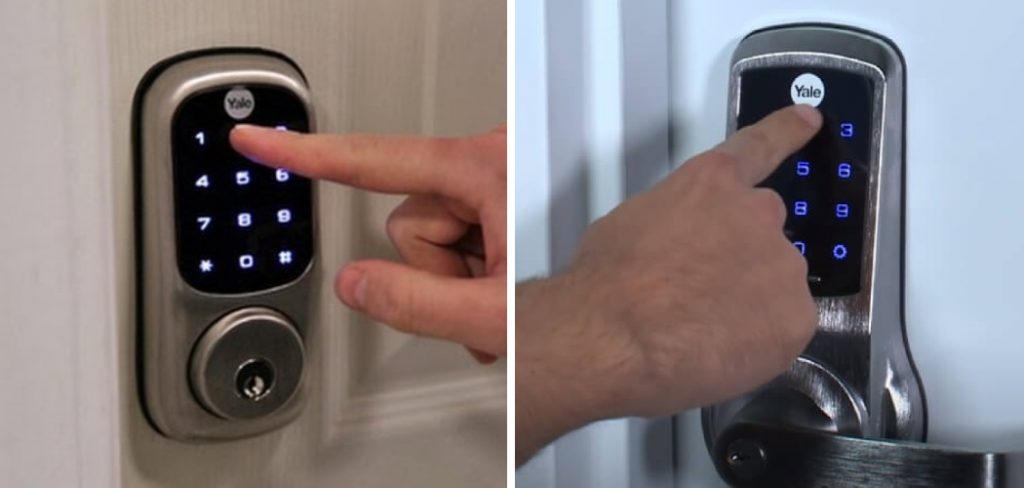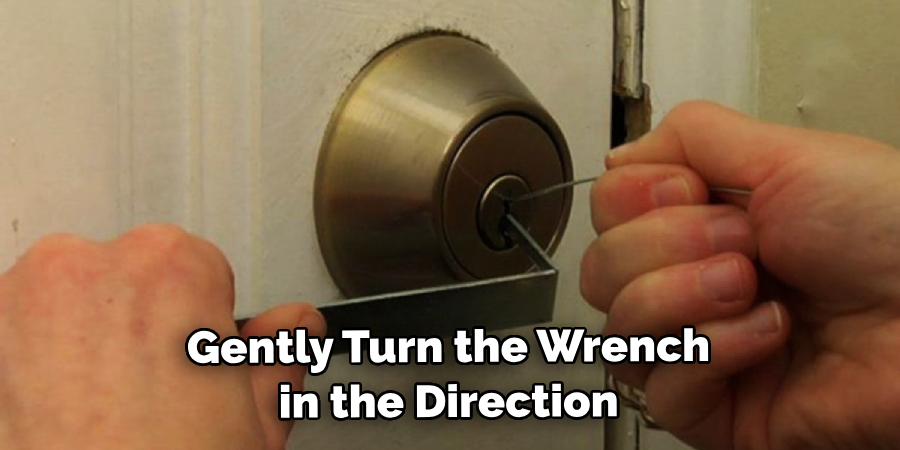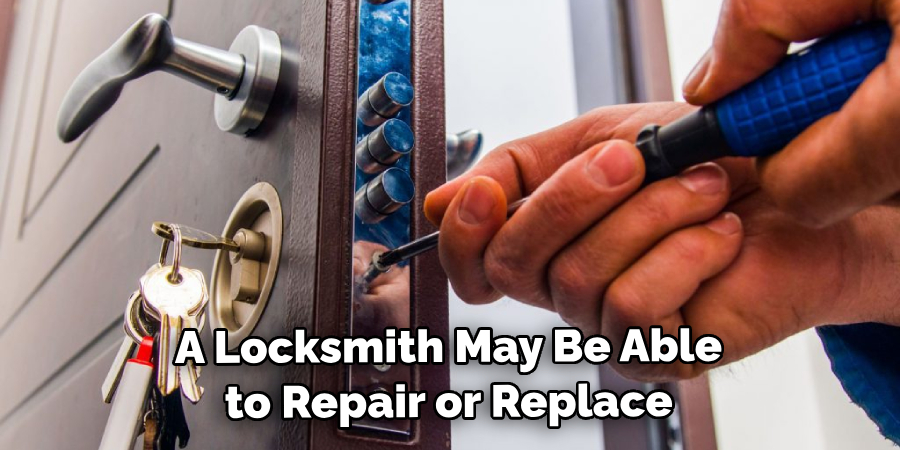Getting locked out of your home or office when you have an important meeting to attend or simply need the rest that comes with being in a safe environment can be extremely frustrating. It’s even more aggravating if the lock is a Yale lock, one of today’s most common yet secure locks on the market. However, it’s not impossible to learn how to open a Yale lock without keys – though it requires patience and know-how.

If you’re ever in a situation where you need to open a Yale lock when locked out, here are some steps you can take.
In this blog post, we’ll take a look at what tools are needed to pick open a Yale lock, as well as helpful techniques for how to open a Yale lock when locked out quickly and efficiently.
What Will You Need?
To open a Yale lock without keys, you’ll need the following tools and materials:
- Lock picking tools (e.g., tension wrench, pick set)
- Lock lubricant (optional)
- Patience!
You’ll be ready to get started once you have all the necessary tools.
8 Easy Steps on How to Open a Yale Lock When Locked Out
Step 1: Lubricate the Lock
Before picking, lubricate the lock with a silicone-based lubricant is always a good idea. This will make it easier for your picks and tension wrench to move freely inside the lock as you pick it open. Additionally, it may help reduce squeaking or sticking noises when picking the lock.

Step 2: Insert the Tension Wrench
Once you have lubricated the lock, insert your tension wrench into the bottom of the keyway and apply gentle pressure in either direction until you feel resistance. This is usually enough to engage the pins inside; any more force may cause them to become stuck or damaged. Be careful not to overdo it, as this can cause the pins to become damaged.
Step 3: Insert the Pick
Once your tension wrench is in place, insert your pick into the keyway and feel for the pins inside. Pay attention to how each pin feels and listen for any clicks or small pops that may indicate a successful move of one of the pins. If you feel any pins sticking or not wanting to move, apply a slight bit more pressure with the tension wrench and try again.
Step 4: Manipulating the Pins
Now that you have your tension wrench and pick in place, you can begin to manipulate the pins inside the lock. Start at the back of the lock and work your way towards the front. Gently rake your pick back and forth across the pins while maintaining slight tension with your wrench. You should feel the pins moving up and down.
The goal is to push each pin up until it clicks and sets at the shear line. Continue this process, pin by pin, maintaining the correct amount of tension. If you lose tension or apply too much, the pins may fall or become stuck, and you’ll have to start over.
Step 5: Checking Your Progress
After you’ve manipulated all the pins, it’s time to check your progress. Maintain your tension on the wrench and slowly try to turn it as if it were the key. If the lock turns, congratulations! You’ve successfully picked the lock. If it doesn’t budge, don’t worry.
This means that one or more pins still need to be properly set. You’ll need to go back and repeat Step 4, paying close attention to each pin’s movement and ensuring each is set at the shear line. Note that this process could take several tries, especially for beginners. Patience is key here, as rushing could damage the lock or your tools.
Step 6: Open the Lock

Once you’re able to turn the tension wrench as if it were the key, the lock should open. Gently turn the wrench in the direction the lock turns, and the bolt should retract, unlocking the door. Remember, exert only as much force as necessary to avoid damaging the lock mechanism.
Step 7: Re-lock and Test
After successfully opening the lock, re-lock it by turning the tension wrench in the opposite direction. Remove your tools from the keyway. At this point, it’s wise to test the lock with the original key (if you have access to it) to ensure no damage was done during the picking process.
Insert the key and turn it. The lock should operate smoothly. If it doesn’t, there could be a problem with one or more pins, and professional help may be needed.
Step 8: Seek Professional Help If Needed
If you are unable to open the lock after several attempts, or if the lock does not operate smoothly with the key after picking, it may be time to seek professional help. Contact a reputable locksmith who has experience with Yale locks. Continued unsuccessful attempts can potentially damage the lock.
Remember to stay calm, and patience is key! With the right tools and techniques, you’ll be able to get back into your home or office in no time.
5 Additional Tips and Tricks
- If you cannot pick the lock using any of the methods above, try shimming the lock open. This could involve using a thin metal piece such as a guitar string or credit card to manipulate the latch and unlock it.
- Another way to gain access is to use a bump key. This involves inserting a specially cut key into the lock and then ‘bumping’ it with a hammer to jolt the pins in the cylinder and open the lock.
- If you have access to a drill, this could be used to open the Yale lock effectively. Although potentially damaging to the lock, drilling through the area where the cylinder is located can gain access without any required special tools or techniques.
- If all else fails, you can always call a locksmith who can open the lock quickly and without damaging the lock itself. Be sure to ask for an estimate of the cost before they start work.
- Finally, always remember that prevention is better than cure; having spare keys in safe places around your home or office can help you avoid lockouts in the future. Make sure to keep spare keys in different places and label them clearly – this will save you a lot of hassle if you ever get locked out again.

There are several ways to open a Yale lock when it is locked. Depending on your circumstances, some methods may be more suitable for you than others; practice caution when using any method of opening a locked lock, as damaging the lock can lead to costly repairs or replacements.
5 Things You Should Avoid
- Avoid using too much force when trying to open a lock – this can lead to broken keys or damaged locks, which will require replacement.
- Only attempt to pick the lock yourself if you have experience, as incorrect methods could damage the lock beyond repair.
- Keep your keys in a different place all the time, as if someone finds them, they will be able to gain access to your property.
- Do not try and drill through the locks, as this can cause permanent damage.
- Avoid leaving spare keys in plain sight – hide them somewhere safe and secure where no one can find them.
By following these simple tips, you can ensure that your Yale lock remains secure and inaccessible to anyone who is not authorized to access it. Remember, if you ever find yourself locked out of your property, several solutions to this problem can be used to open the lock without causing significant damage.
Why is Your Yale Lock Not Unlocking?
Sometimes, your Yale lock may not be unlocking due to a fault in the mechanism. If this is the case, it is important to identify and resolve the issue before attempting any of the methods above. Common causes of faults include worn out pins or springs, debris build-up in the lock cylinder, or rust on the locking mechanism. In these cases, a locksmith may be able to repair or replace the lock, depending on the severity of the issue.

It is also worth remembering that if you need to remember your combination, most Yale locks can be opened using a professional bypass key. This will allow you access to your property without damaging the lock or taking other drastic measures. However, these keys should only be used by a professional locksmith, as they can cause severe damage to the lock if not used correctly.
By taking the time to understand how your Yale lock functions and familiarize yourself with the methods of unlocking it in an emergency, you can save yourself from potential stress and hassle in future lockouts.
Conclusion
Opening a Yale lock without the key can be a successful operation with the right tools and procedures. If you need all the necessary equipment to open the lock yourself, it is recommended that you contact an experienced locksmith. However, be careful when opening a lock without a key, as this can potentially cause damage to both the lock and door frames.
With proper precaution, understanding of tools, and patience, opening your Yale Lock may only be a few steps away. Always respect other people’s property, and don’t be tempted to use these methods for any unlawful purpose.
Overall, by following appropriate guidelines for how to open a Yale lock when locked out, there is no need to fear losing the key again.
About
Safety Fic is a distinguished figure in the world of Diy design, with a decade of expertise creating innovative and sustainable Diy solutions. His professional focus lies in merging traditional craftsmanship with modern manufacturing techniques, fostering designs that are both practical and environmentally conscious. As the author of diy, Safety Fic delves into the art and science of Safety Fic-making, inspiring artisans and industry professionals alike.
Education RMIT University
(Melbourne, Australia) Associate Degree in Design (Safety Fic) Focus on sustainable design, industry-driven projects, and practical craftsmanship. Gained hands-on experience with traditional and digital manufacturing tools, such as CAD and CNC software.
Nottingham Trent University
(United Kingdom) Bachelor’s in diyfastly.com and Product Design (Honors) Specialized in product design with a focus on blending creativity with production techniques. Participated in industry projects, working with companies like John Lewis and Vitsoe to gain real-world insights.
Publications and Impact
In diy, Safety Fic his insights on indoor design processes, materials, and strategies for efficient production. His writing bridges the gap between artisan knowledge and modern industry needs, making it a must-read for both budding designers and seasoned professionals.
